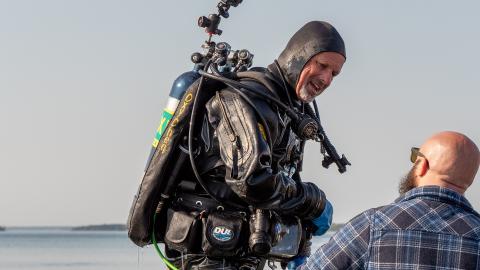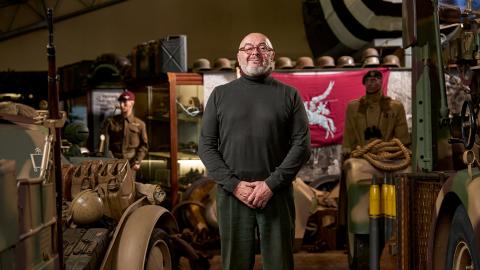Pirates, Fact vs. Fiction - 'Talk Like A Pirate Day'
Every year, the 19th September is 'Talk Like a Pirate Day'... Let Sky HISTORY help you really get into character.
Over the centuries a lot of myths around pirates have become popular, making it hard to untangle pirate fact from piratical fiction. This is where Black Sails comes into its own, giving us a view of early 18th century pirate life which is as gritty as it is realistic.
Here, pirate expert Angus Konstam does some pirate myth-busting, stripping away the fiction to reveal just how real pirates operated in the early 18th century, giving you the chance to get into character.
Buried Treasure
Pirates didn't bury treasure. Instead their plunder was kept on board the ship, before being divided up among the pirate crew. The notion of buried pirate treasure comes from Robert Louis Stevenson's magical book Treasure Island, first published in 1883, where it was a useful plot device. Black Sails is based twenty years before the events of Stevenson’s classic novel.
So too was a pirate treasure map, where "X" marked the spot. The only pirate known to bury anything was Captain Kidd, but that was outside New York, to prevent his plunder being seized by the city's governor.
Talk like a Pirate
Today, we all expect pirates to talk in a rich West Country accent. 19th September is even International Talk like a Pirate Day, where people are encouraged to say "Avast me hearties", or "Arrrr matey". In fact, real pirates talked in whatever normal accent they happened to have. Some came from London, some from Bristol, some were Scottish, some were French - there was no recognisable pirate tongue. What we know as 'pirate speak' all stems from Dorset-born actor Robert Newton, who played Long John Silver in Walt Disney's Treasure Island (1950).
Eyepatches and Peg Legs
Anyone dressing up as a pirate today would probably consider putting on an eyepatch, or pretend to have a peg leg or a hook for a hand. Again, this "look" has its roots in fiction - Long John Silver had a wooden leg in Treasure Island, while Captain Hook had a hook for a hand in Peter Pan. This though, at least had some basis in fact, as sailors could lose eyes or limbs in battle, or in a shipboard accident. While a pirate with a peg leg couldn't climb the rigging, he could at least act as the ship's cook, hence the one-legged cook Randall inBlack Sails (played by Lawrence Joffe)
Walking the Plank
Pirates never made their victims walk the plank. That was the invention of J.M. Barrie, who wrote Peter Pan (1904). Real pirates of theBlack Sails era wouldn't bother. It was much easier to stab or shoot their victim and throw him over the side. Even if he were still alive, the sharks would do the rest.
Pirate Fashion
Today, anyone dressing up as a pirate would probably wear a bandana around their head, a scarf around their waist and probably put on a pretend earring. Real pirates never looked like this - it was a look invented by the American artist Howard Pyle in the late 19th century.
When he was asked to illustrate children's pirate books, he drew on Spanish bandits for his inspiration. Real pirates of the period just wore the same clothes as any other early 18th century sailor.
Pirate Gold
In most of the old swashbuckling films, pirates captured cargoes of Spanish galleons laden with gold and silver. In fact, these were very rare as these Spanish ships were too well protected, so pirates left them well alone. The exception came in 1715, when treasure ships were shipwrecked on the Florida coast - an event mirrored in Black Sails with the quest for the gold carried by the Spanish treasure ship Urca de Lima, the richest ship in the 1715 treasure fleet.
"Them's that Die is the Lucky Ones"
A pirate's life is often seen as one of freedom and choice. In fact many pirates were forced into a life of crime when their ship was captured, or their shipmates mutinied. Others turned to piracy to escape the harshness of life as a merchant seaman of the period, where conditions were tough, and the pay was poor. Piracy though, was not a good career choice. Most pirates were caught within a year, and were either killed in battle, or tried and executed, as a warning to others.
Hoist the Jolly Roger!
One of the few aspects of pirate life that hasn't altered its potency over the centuries is the use of the pirate flag - the "Jolly Roger". The term comes from the French jolie rouge, a reference to the red flag used by privateers in the 17th century.
Articles continues below.
This developed into the black flag we know today, decorated with motifs designed to intimidate potential victims. Skeletons, skulls and weapons all served as a warning of what might happen if a victim refused to surrender.
A Jolly Band of Pirates
Gilbert and Sullivan's comic opera Pirates of Penzance has a lot to answer for. This is where the idea of pirates wearing skull and cross bone decorated hats came from, as well as the idea of the jolly pirate band, whose members were unthreatening figures of fun. This is a far cry from real pirate crews of the Black Sails era, who were capable of murder, rape and torture, if given the opportunity. A strong leader - someone like Black Sails' Captain Flint - was needed to keep a pirate crew in check.
Pirates in every port
Pirates were criminals, operating outside the law. This meant that law-abiding ports were closed to them. As a result, they were denied access to markets where they could sell their plunder - which was more likely to be cloth, timber, tobacco, spirits or even slaves than gold and silver. The exception - for a few brief years - was Nassau in the Bahamas - the bustling pirate haven brought to life in Black Sails. Without it, and without Nassau merchants willing to deal in stolen goods, pirates would have struggled to turn a profit from their life of crime.















